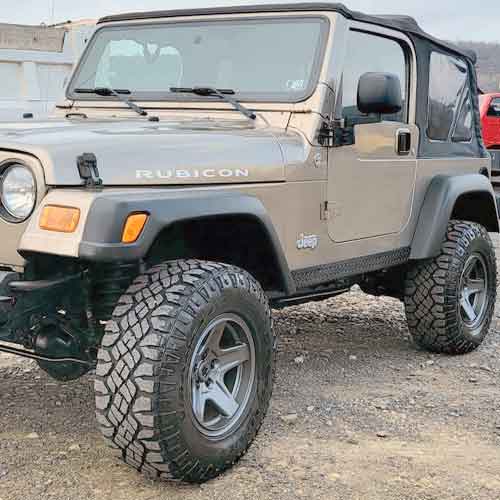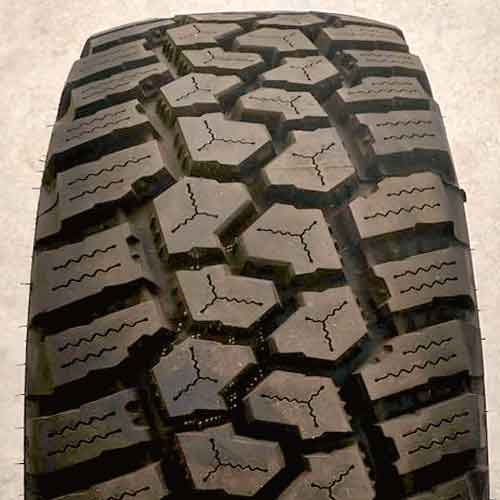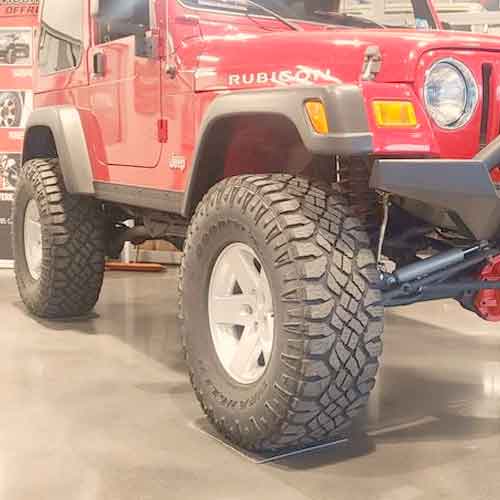Goodyear Wrangler Duratrac and the Cooper Rugged Trek are both designed for all-terrain use, but they cater to different types of customers. The DuraTrac is a commercial all-weather tire, while the Rugged Trek is a rugged terrain tire with good on-road manners. However, there are certain applications where these tires intersect.

In my professional opinion as a tire engineer, my tests showed me that the Cooper Rugged Trek is a better tire to have on (dry) roads, as the tire offers superior grip, tread wear and noise dampening abilities. And off-road it’s one of the best tires for gravel out there. On the other hand, the Goodyear Duratrac handles mud, sand and soft snow more effectively, and on highways it yields a greater traction on wet roads. Though the tire is very loud, lacking in overall comfort department.
Tire Sizes
Let me start things off with the famous Goodyear Wrangler Duratrac.
- It offers 15 to 22″ rim sizes
- Has weight range: 35 to 68 lbs
- Comes with speed rating: Q, S, P, and T
- Load rating goes up to F
- Tread depth seen on most sizes: 16/32″, where maximum seen is 18/32″
- 3PMSF and M+S ratings available on all sizes
- 50k miles tread wear warranty (excluding LT sizes)
Cooper Rugged Trek on the other side, has following specs.
- 18 total sizes in 16″ to 20″ (rim diameter)
- They have speed ratings in either T or Q
- Load ratings: SL, XL, E and F
- Weight range: 40 lbs to 70 lbs
- Tread depth: Either 16/32″ or 18.5/32″
- All sizes have 3pmsfr
- LT sizes have 55k miles warranty, while others have 65k
Tire Toughness
Both of these tires although features a very aggressive structure on the outside, internally, they are not durable enough.
They both have conventional 2 ply polyester casings, which are then layered with 2 wide steel belts. It’s a very common set up, which is usually seen on all types of terrains, even on-road ones.
Though at-least the Goodyear Duratrac provides you with 2 cap plies of nylon on top of those layers, the Cooper Rugged Trek only has a single layer.
Tread Features
The Cooper Rugged Trek tire has elongated sidewall lugs with embedded biters/notches, that provide improved off-road performance (when used with lower air pressure, especially).

The shoulder lugs are staggered and have full depth interlocking sipes, that create a wave-like pattern, and adding to the tire’s aggressiveness, are big/thick mud scoops, which spoon the dirt out of the tread.
Though with such wider gaps, the overall on-road traction gets to be compromised a little bit, even though these lugs are quite stable, as they are placed on secondary rubber layers underneath, which also act as stone ejectors.
But the tire gives great directional grip on roads not doubt about that.
This is because the lugs in the middle are more packed up and make larger contact with the road enhancing friction and with it, grip.
They also make Y shaped siping design supplying good enough wet traction.
And the ridges (supporting sides, which also act as biters) renders the stability on higher speeds, along with off-road biting, at the same time.
On the other side, the Goodyear Duratrac shows up with an equally aggressive structure.

On the sides, it has “pairs” of shoulder lugs which are pretty bald and surrounded by clear-cut circumferential grooves, dividing them from the middle.
These shoulder lugs extend down towards the sidewalls and make decent biters there as well.
In the middle, lugs get to be smaller and more packed up. They are actually optimized for better directional traction performance.
And with reinforced foundations underneath, they also account for stability during cornering, and braking (for the most part).
Last but not least, the tire offers tractive grooves, which is just what they call, embedded biters on the base of the tread voids.
Think of them as a secondary tread pattern on the grooves. They basically act as stone ejectors and provide amazing mud traction.
Dry Traction
On dry roads, the traction is evaluated with directional grip and lateral traction.
Directional grip is measured with braking distances and it depends on the central part of the tread, where the tire/vehicle’s whole weight is focused upon. While the other part, lateral traction depends on shoulder lugs, (as the weight shifts towards the sides, during cornering).
And considering both parts of the tread, it makes sense why the Cooper Rugged Trek gets to have an upper hand, with it’s better footprint offering, form both the middle and outer ribs.
The Goodyear Duratrac on the other side, has a lot more gaps/voids, especially towards shoulders, so it’s not able to bring in same results. Moreover, with its relatively spongier compound, the lugs bend a lot more in comparison, and this impact the steering response of the tire, negatively.
Wet Traction
The size of the tire’s contact patch may not be the most important factor in wet road traction, but rather the effectiveness of its sipes.
Sipes are cuts in the tread, that allow water to be stored in, and then expelled out, and they need to be flexible to do this effectively.
Both tires although offer a ton of siping with interlocking structure, the overall wet performance is still better seen on Goodyear Wrangler Duratrac.
This is because the tire has a malleable tread compound in comparison and it allows its sipes to flex in a better way, creating a more forceful suction for the water particles.
The Cooper Rugged Trek on the flip side lacks with it’s stiffer composition. So even though it brings you with a great interlocking siping structure, it still renders longer braking distances and handling times.
Tread Wear
When it comes to tread wear, there are 2 main aspects to keep in mind, tread-wear-time, and wear-rate.
And since both of them are seen better on Cooper Rugged Trek, you get a longer life out of it.
Like already mentioned, its tread consists of a harder compound, with a greater Kevlar composition, so it’s not that prone to burning “quickly” (in comparison). And with slightly deeper tread voids, it also takes more time to reach down to the legal tread depth limit.
The Goodyear Duratrac on the flip side, burn off slightly faster with it’s softer compound and shallower tread dpeth. Nonetheless, the difference is very low between the two. And there are a lot of things you can do to improve its overall tread life.
Overall Ride Comfort
Ride quality is a measure of a tire’s ability to provide a smooth, comfortable ride and so it depends on two things, on-road vibrations, and noise. Let me talk about them both.
Road Vibrations
The material composition of the tire’s carcass, layers, and outside tread, all impact ride quality to a great extent.
And although internally the Cooper Rugged Trek offers with just a single cap ply, (instead of two, seen on competitor), it’s stiffer rubber composition, is still not that great at settling down the bumps on, and off road.
Goodyear Duratrac on the other side, offers better cushioning. It’s softer compound keeps bumps at bay, and with solid reinforced foundations underneath, its blocks also stay in place, so you also get good enough stability on smooth pavements with this tire, comparatively.
Tread Noise
Balder tires generate more on-road noise. This is because noise is just air particles hitting the tread walls, and with larger tread voids, its not restricted.
That’s why the Goodyear Duratrac gets to be the victim here. It’s wild outer circumferential groove rings act as a huge playground for those air particles.
Moreover, it’s softer compound also create more in-groove resonance, (noise easily bounces off form one wall to another).
Cooper Rugged Trek on the other side features Whisper Grooves. If you consider it’s tread again (by scrolling to the Appearance section above), you’d note that, between the shoulder lugs, there are stoppers.
These connectors not only add stability to these lugs, but also restrict the air particles form getting in, providing a quieter ride.
Snow Performance
On snow there are two main types of terrains to consider, harder on-road snow/ice, and deeper terrains.
And testing these tires in both LT and P metric sizes, I would have to go with Goodyear Duratrac, even though both tires have 3 peak mountain snowflake rating.
The tire basically comes with narrower section width, and a lot more biters.
With narrower section width, it puts more pressure on the ground, allowing snow to easily get pushed in. This allows the tire to form a superb connection between the lodged snow and the ground, yielding better friction (as rubber to snow shows more slippage, relatively).
Moreover the biters embedded within the grooves of the tire (which Goodyear calls Tractive Technology), ensures they don’t escape.
Cooper Rugged Trek on the other side, although is pretty capable of same phenomena (of holding snow) with it’s outer ridges (between shoulder blocks), it still lacks mostly due to it’s harder compound, which is not as thermal adaptive.
Meaning with freezing temperatures its more prone to getting stiffer. So it’s biters aren’t that flexible to bite in to the ground.
Also Read –
Are A/T tires good in Snow: https://tiredriver.com/are-all-terrain-tires-good-in-snow/
Off Road Performance
Off-road there are a lot of variables to consider. So to make things easier to understand, I’ve divided this section in to the following terrains.
Dirt Filled Roads
Dirt and sharp stones are handled with stone ejectors. And since the Goodyear Duratrac is missing with those, its not able to do great in this department.
The Cooper Rugged Trek on the other side, has a ton of these ejectors, so it’s tread is very unwelcoming to any kind of sharp particles, that may hurt the tread and loose traction values.
Desert Performance
Desert is a very soft terrain, where you have to avoid as much digging as possible. That’s why it’s always recommended to lower the tire’s air pressure, so it could have floating abilities.
That’s why out of both tires, you are better off here with Goodyear Duratrac, with it’s softer compound molding over sand in a better way. Moreover the tire also features softer outer edges which are not as prone, to sinking, relatively.
Cooper Rugged Trek on the other side, features a more rigid compound, and a slightly greater weight, so it’s not able to outperform its counterpart.
Muddy Tracks
Self-cleaning tires are ideal for driving on mud, as they can clear the thick debris from the tread more effectively. But with both tires having a bald enough structure, may make things difficult in choosing.
Luckily my testing would save you some time, as it shows that the Goodyear Duratrac is a better tire to have here mainly because of it’s tractive groove technology.
It’s off-set edges already cut down the mud particles, and they are further digested down with the help of biters embedded within the grooves, so it could pass out of the tread with more ease.
Cooper Rugged Trek on the other side, does not offer cutting down the mud particles as effectively.
Moreover, as I mentioned in the noise section, the tire comes with Whisper grooves, having ridges placed between the shoulders. These restrict the mud particles form leaving out through sideways.
On Rocks
On rocky terrains, durability and strong gripping are key factors for successful performance. And although here, both tires lack in providing tough enough structures, they yield superb traction in all directions.
Though still I would pick Cooper Rugged Trek over the other, mainly because of it’s amazing biting abilities form the sidewall lugs (with lowered air pressure).
The tire actually provides dual sidewalls, with each carrying sets of more powerful biters.
The Goodyear Duratrac on the other side, although provides similar grip form the middle, it’s sidewalls could use some extra biting efficacy.
Winding Up
Goodyear Duratrac yields superior performance on roads when it comes to winter and wet traction, and off-road, the tire stays unbeatable on muddy and sandy tracks.
On the other side, the Cooper Rugged Trek does better on dry pavements, offering superior fuel economy and tread life.
And on rugged terrains, it won’t disappoint you at all on gravel and dirt filled terrains.